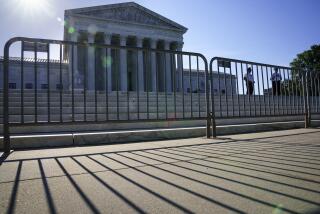TV REVIEW : ‘This Honorable Court’ Humanizes the ‘Nine Old Men’
- Share via
In “This Honorable Court,” PBS’ two-part documentary on the most mysterious and least understood branch of American government, there is one short scene that shows, more eloquently than any learned biographer ever could, the pain, the pleasure and the isolation of sitting on the U.S. Supreme Court.
Chief Justice William H. Rehnquist, pressed for time but in need of exercise, lopes around Capitol Hill in the cold, bundled up in an overcoat and a funny hat. He rates not a second glance from passers-by, for despite his grand title and greater burdens, he is rarely recognized. And he takes along for companionship and conversation a young clerk, one of the few people in Washington with whom he can ever be completely candid.
“This Honorable Court,” to be broadcast tonight and next Monday (8 p.m. on Channel 50, 9 p.m. on Channel 15, 10 p.m. on Channels 28 and 24), is perhaps the most ambitious study of the Supreme Court ever undertaken by television and offers other choice vignettes:
Justice William J. Brennan, the court’s senior member at 82 but still lively, explains why he dissents every time the majority approves the death penalty, even if he can’t switch anyone else’s vote. Justice John Paul Stevens, in shirt sleeves, confesses that he sometimes changes his mind about a difficult case two or three times as he weighs advice from his clerks and his colleagues.
And Thurgood Marshall, the only black justice in history, complains about conservative critics who insist that the high court, in interpreting the Constitution, should be bound by the “original intent” of the Founding Fathers. The Constitution is a “living document,” he says tartly. “I don’t want to be held to the same thing my father was held to. That would mean I’d have to ride in the back of the trolley car. And I’m not going to.”
Paul Duke, the show’s host, manages to interview on camera all nine members of the current court, including several who are notoriously camera-shy. Unfortunately, most of the best footage has been saved for next week’s installment.
Viewers who tune in tonight will find instead a perfunctory pictorial history of the high court, from its shaky beginnings, when it was widely scorned and was mistakenly dubbed “the least dangerous branch of government,” to last year’s furor over the aborted nomination of Judge Robert H. Bork.
Obviously it’s impossible to understand the Supreme Court without some knowledge of the decisions that established the supremacy of the national government and the court’s authority to strike down acts of Congress, but by devoting all of the first show to history, PBS takes the risk that viewers won’t come back next week.
That would be a shame, because the second show offers unrivaled shots of the parts of the court off-limits to visitors, from the conference room--the inner sanctum where the justices discuss cases and cast their secret votes--to the basketball court just under the roof where clerks and an occasional justice let off steam on what is jokingly called “the highest court in the land.”
Best of all, however, are the interviews, which ought to dispel forever the idea that the justices are starchy or inaccessible. Justice Antonin Scalia, teased about his habit of peppering lawyers with so many questions that they lose track of their arguments, admits, “The devil makes me do it.”
For laymen, there are also insights about the painstaking process of assembling an opinion that will command the votes of a majority, as the justices trade drafts, tinker with each other’s prose, strike compromises and sulk a little. Some of them acknowledge that they are overwhelmed by the demands placed on them to solve insoluble problems. Rehnquist, recalling his first days on the court, modestly says that “it was almost mind-boggling. Here we were deciding things of great import, and . . . I felt, ‘Who am I to be doing this?’ ”
If nothing else, these programs ought to correct the widespread perception of Rehnquist as a callous, arrogant conservative. The camera catches him poking fun at himself, leading Christmas carols at the staff’s party and, with a wide grin, explaining how little power a chief justice actually wields over his independent-minded colleagues since he’s not their boss, only “first among equals.”
Overall, PBS achieves a light and chatty tone that helps humanize the court. But with sharper questions and a harder edge, Duke might have made more news. He openly criticizes both the court’s Dred Scott slavery opinion and the “nine old men” who blocked so much New Deal legislation. But he slides over controversies of more recent vintage, such as the mounting criticism of the 1973 abortion decision and the current court’s slow erosion of some landmark Warren Court criminal decisions. Getting the justices to talk about those cases, on the record, would have been a real coup.
More to Read
The complete guide to home viewing
Get Screen Gab for everything about the TV shows and streaming movies everyone’s talking about.
You may occasionally receive promotional content from the Los Angeles Times.






